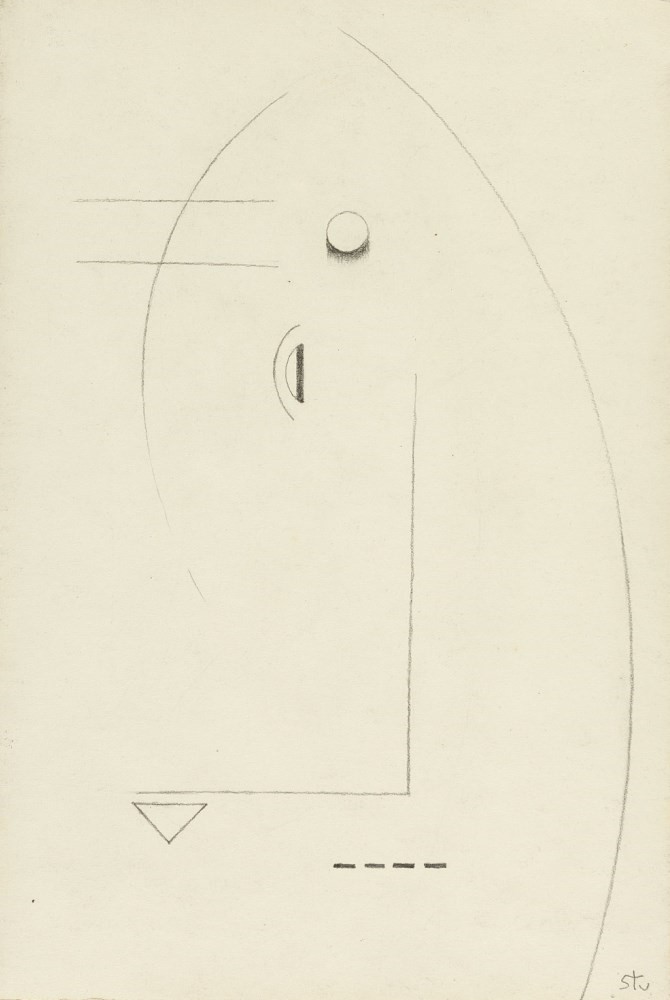Drawing on wove paper by Fritz Stuckenberg – Untitled abstract construction circa 1930
Original drawing by Fritz Stuckenberg – Untitled abstract construction circa 1930.
Pencil drawing on wove paper monogramed on lower right.
Unframed
Dimensions: 26 x 17.5 cm – 10.2 x 6.9 in
Provenance: Galerie Gunzenhauser, Munich
Reference: Fritz Stuckenberg, Retrospective “, Municipal Gallery, Delmenhorst January 24-28, 1993.
Price: *CAD (Canadian dollar) For price, shipping and details or more information on the artist contact the gallery.
Clic here to see more artworks on paper >>
Fritz STUCKENBERG (1881 – 1944)
Fritz Stuckenberg was born in 1881 on August, 16 in Munich and died on May, 18, 1944, in Füssen. He was a German avant-gardist, expressionist and constructivist painter.
Friedrich Bernhard Stuckenberg was born in Munich. His family moved in 1893 to the northern industrial city of Delmenhorst near Bremen, where his father took over as director the Hansa-Linoleumwerke.
Friedrich started studying but after unfinished studies of architecture and art in Weimar and Munich, he left and spent five more formative years from 1907 till 1913 in Paris whose leading role as the cultural capital of the 19th and early 20th centuries attracted artists from all nations. Fritz Stuckenberg also found artistic inspiration and “the new” in Paris was for him the liberation to light and color. From there he made excursions to Pont-Aven as well as to Provence in Cassis and Martigues regions, he “cleaned his palette”. He belonged now to the circle of artists of the “Café Du Dôme” and exhibited in some of the best salons and galleries in Paris.
Coming back to Germany in 1913, he took residence in Berlin where he was discovered by Herwarth Walden and in 1916 he integrated into the Sturm circle. He became friends with Georg Muche, Arnold Topp, Walter Mehring and Mynona. Disillusioned with Walden, he joined in 1919 the Arbeitsrat für Kunst around Walter Gropius and Bruno Taut, later the Novembergruppe. Several “Sturm”-exhibitions, participation in the first Berlin Dadaist exhibition, and inclusion in the third Bauhaus portfolio, mark his rank in the artists’ scene of these years. In the early 1920s, his works were shown in Germany, the USA and the Soviet Union as that of a pioneer of the European avant-garde.
Severe illness and financial problems forced Stuckenberg nevertheless to return to his parents in “gloomy Delmenhorst”; as he writes in a letter to the Flemish dadaist Paul van Ostaijen. Under increasingly difficult conditions, both political and personal, he managed to develop a late constructivist and spiritualist work.
From 1933 on all of his pictures were removed from German museums and some of them destroyed during the Nazi purges. In the infamous exhibition on “Entartete Kunst” in 1937, his “Straße mit Häusern” (street with houses, 1921); was exhibited as an example of “degenerate art”.
During the Second World War he moved to the South of Germany and died there, already almost forgotten.
In 1993 he was rediscovered as a part of the modern art avant-garde with a retrospective in Delmenhorst, Berlin and Neuss. A large part of his surviving work is now to be seen in the Städtische Galerie Delmenhorst.
#biography – YLA and Wikipedia
Date:
November 28, 2021
See more artworks and bio of
Drawings